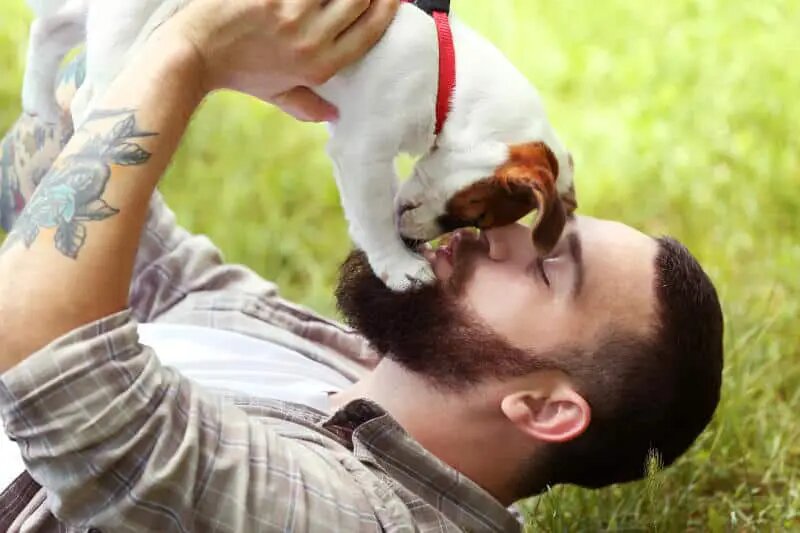
Adopting a furry companion might be the best decision you’ll ever make! Besides love and companionship, which couldn’t be more valuable than during these strange times, there are also tangible health benefits to dog ownership. How fantastic is that?
There are some really important things to focus on when you bring a new dog (either young or young at heart) into your home. They’re the ones that can make your life together either a smooth or turbulent sail. We’ve identified below a few of the biggies to focus on and have a few suggestions of where to go to learn more!
Establish Trust
Helping your new pup know that he can trust you is important for your dog’s emotional safety as well as for your own physical safety.
While any pup that you bring into your house will be starting from a different place, there are things you can do that will work with most dogs.
It’s intuitive, yet a bit hard to do when you are so excited about your new family member, but you need to move slow and remain calm.
Your slow movements and calmness will help your pup settle in!
There are other tactics that can help if you have a fearful dog – don’t make eye contact, let your pup approach you, hand feed them, etc. Just remember that a bit of work at the beginning will pay back in years of unconditional love.
Nail House Training
House training is an obvious first with a puppy, but often, even an older pup might get confused and backslide in this area especially when they enter a new home.
Supervision coupled with lots of trips out to your pup’s “toilet area” is going to be the key to success! Short term confinement ((in a crate) can really help – especially when you can’t be there monitoring your pup.
Every time you release your pup from the confinement area (try to do this once an hour at the beginning) run her out to the toilet area (if need be on leash).
Tell your pup what you expect when you get to the toilet area. We say, “go pee-pee,” not super dignified but it works! When she does it – praise and treats!!
We actually had a pup who would squat and then look up at me for a treat It works!
Build a Rock-Solid Recall
Recall is the most important skill to teach any dog. It’s handy if your dog ever escapes your yard, or if you ever want to enjoy an off-leash hike in a wooded area.
Start teaching recall early, and practice every single day. This is really all about safety, but it will also prevent you from getting irritated at your pup.
The first rule is to never scold your dog when he comes to you. Even when you’re calling your dog, and he ignores, rolls in a fresh pile of manure, then finally comes happily racing back – you can’t scold!
The next two rules are to use a consistent cue (“come” or a specific whistle) and reward!!!
Rewards work (for catching Billy the Kid AND training your dog)!
For most, the best reward is a treat but for some a ball or squeaky toy might work better. It will become pretty obvious what type of dog you have!
Use Rewards-Based Training
There are a lot of other useful things to teach your pup. One of our favorites is “wait” – so useful to have your pup pause for a second – before diving into her food, jumping out of the car, running out the door, etc.
Reward based training uses treats, praise, toys, & play as motivators to teach your dog new behaviors.
This method of training teaches your dog that if he does what you ask then he gets a reward. Reward-based training is the best way to teach your dog new behavior because it’s effective, simple, and it enhances your relationship – all worthy goals.
The timing of the reward is crucial because it helps your dog understand exactly what behavior is being rewarded.
Therefore, it’s important to give your dog his reward at the exact same moment that your dog performs the desired behavior.
For example, when teaching a dog to sit, you should give the reward as soon as his behind touches the ground. This will ensure that he knows he is being rewarded for sitting down. Delay will cause confusion.
Jiminy’s Training Treats
At Jiminy’s, we have some treats designed to be an anytime snack while some of our other treats are specifically designed for training.
For training, the criteria is very specific. We worked with Ian Dunbar (Animal Behavior Expert) to think through the important qualities necessary for effective training treats!
It was hard work, but we think we hit the nail on the head with those treats!!!
- Size & Shape – needs to be small so it can be eaten quickly without distracting from the task at hand; also needs to be easy to hold
- Low Calorie – learning something new takes many repetitions so keeping treat calories under control is vital – our training treats are under 3 calories per treat
- Convenience – the treats need to be easy to carry in your pocket or treat bag and not greasy (yuck) or crumbly
- Healthy – treats should be healthy and, better still, able to supplement your dog’s normal diet with added health benefits (example: omegas, vitamins, fiber, etc.)
- Delicious – a bit subjective, of course, but treats must excite your dog because otherwise they won’t work as a training tool
Not only do Jiminy’s training treats deliver on all of these criteria, but, because they’re from Jiminy’s, they’re also sustainable, humane and great for dogs with allergies! The best treat for your pup and your planet.

Additional Resources:
https://www.dunbaracademy.com/
Zoom or In person classes in the San Francisco Bay Area:

